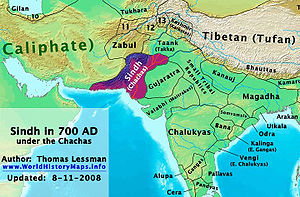- Chach Nama
-
Chach Nama (Sindhi: چچ نامو) also known as the Fateh nama Sindh (Sindhi: فتح نامه سنڌ),and also known as Tarekh-e-Hind wa Sindh Arabic (تاريخ الهند والسند ) is a book about the history of Sindh, chronicling the Chacha Dynasty's period, following the demise of the Rai Dynasty and the ascent of Chach of Alor to the throne, down to the Arab conquest by Muhammad bin Qasim.
Contents
Authorship
The Chach Nama was written by Kàzí Ismáíl . Kází Ismàíl was appointed the first Kází of Alór by Muhammad Kásim after the conquest of the place .
“ Sakifís—The Kàzís of Bakhar and Alór or Rohrí are descended from Músá son of Yaakúb son of Táí son of Muhammad son of Shaibán, son of Usman Sakifí. The author of the conquest of Sind in Arabic, from which Chachnámah was translated, Kàzí Ismáíl son of Alí son of Muhammad son of Músá, son of Táí, is one of the descendants of the same line. Músá son of Yaakúb was the grandson of this gentleman Kází Ismàíl and was appointed the first Kází of Alór by Muhammad Kásim after the conquest of the place [1] ” It was translated into Persian by Muhammad Ali bin Hamid bin Abu Bakr Kufi in 1216 CE.[2] from an earlier Arabic text. At one time it was considered to be a romance until Mountstuart Elphinstone's observations of its historical veracity. The original work in Arabic is believed to have been composed by the Sakifí family, the kinsmen of Muhammad bin Qasim.
Sources
The sources of Sakifi collections may be classified as follows:—
- Arab historical lays, and ballads.
- Family traditions of the Sakifís, recorded and unrecorded.
- Stories told by individuals whose names were forthcoming.
- Stories traceable to individuals of a certain caste, e.g., Brahmins.
- Hearsay and apochryphal stories.
- The correspondence between Muhammad Kásim and Hajjáj.
Accuracy
The Táríkh Maasúmí, and the Tuhfatulkirám are two other Muslim histories of the same period and on occasion give differing accounts of some details. Later Muslim chronicles like those by Nizam-ud din Ahmad, Nuru-l Hakk, Firishta, and the Mir Ma'sum draw their account of the Arab conquest from the Chach-Nama.
While Kufi is also seen as having employed some "Purple prose" he is regarded as having accurately translated the bulk of the Arabic material as well attributing the sources of information, whether they are from individuals or even "tradition".
As a historical narrative the account is seen as a valuable record of events such as the social, political and historical geography of the region at the time, while containing the natural bias of the Sakifi family as well as the inherent inaccuracies and embellishments of popular tradition.
References
- ^ HISTORY OF SIND. VOLUME II. (IN TWO PARTS.) Part II—Giving the reigns of the Kalhórahs and the Tálpurs down to the British Conquest. TRANSLATED FROM PERSIAN BOOKS BY MIRZA KALICHBEG FREDUNBEG, CHAPTER IV
- ^ Common Era year is an approximation of the Islamic calendar date 613 AH.
Further reading
- The Chach-nama. English translation by Mirza Kalichbeg Fredunbeg. Delhi Reprint, 1979.
External links
Categories:- Arabic literature
- History of Hinduism
- History of Buddhism
- Historiography of India
- History of Pakistan
- History of Sindh
- History of Islam
- Persian literature
- 8th-century Indian books
- 8th-century history books
- Chach nama
Wikimedia Foundation. 2010.

